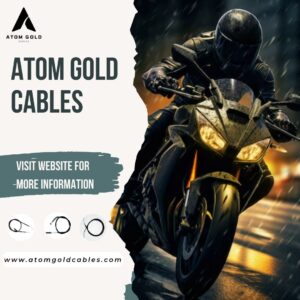Control cables play an essential role in two-wheeler safety. These cables—responsible for functions like braking, throttle, and clutch—help riders control their motorcycles or scooters more precisely. High-quality control cables reduce the risk of accidents by providing reliable, responsive handling, allowing riders to navigate the road safely.
This article explores how quality control cables enhance two-wheeler safety, the different types of cables used, and maintenance tips to keep them in top condition.

The Role of Quality Control Cables in Two-Wheeler Safety
Control cables translate a rider’s input into actions, weather accelerating braking or shifting gears. When cables are durable and well made they perform these functions reliably. on two-wheelers, where every movement counts, quality cables reduce the risk of sudden issues that could cause accidents. By investing in quality cables, riders benefit from smoother, safer performance on the road.
Types of Control Cables and Their Safety Roles
Each control cable on a two-wheeler has a specific job:
- Throttle Cables: These cables manage the motorcycle’s acceleration. A smooth throttle cable allows the rider to control speed accurately, which is crucial for safely navigating turns and avoiding obstacles.
- Brake Cables: Brake cables transmit force from the lever to the brakes, helping riders stop or slow down quickly. A reliable brake cable is essential for emergency stops and sudden decelerations.
- Clutch Cables: Clutch cables enable gear changes on manual motorcycles. A strong clutch cable allows for smooth shifting, which keeps the bike stable, especially when changing gears at high speeds.
Why Quality Matters in Control Cables
Quality control cables are built to withstand frequent use and various weather conditions. They are made with high quality materials that resist wear and corrosion, ensuring they last longer and work smoothly. In contrast, lower-quality cables may wear out quickly, leading to delays, stretching or even complete failure
Key qualities of high-grade control cables include:
- Durability: Quality cables resist wear and can handle frequent use without breaking.
- Weather Resistance: High-quality cables are protected against rust, dust, and rain, making them reliable even in tough conditions.
- Smooth Movement: These cables are designed to move effortlessly, allowing riders to control the two-wheeler with ease.
Signs of Worn or Damaged Control Cables
Recognizing early signs of cable wear can prevent unexpected issues on the road. Common indicators that a cable may need replacing include:
- Increased Slack: If the brake, throttle, or clutch lever feels loose, the cable may be stretched, affecting its performance.
- Delayed Response: A lag in response when braking or accelerating suggests that the cable might be damaged.
- Fraying: Frayed cable strands signal wear and may eventually lead to cable breakage.
- Corrosion: Rust on cables can cause stiffness and make them less effective.
- Stiff Movement: If the cable feels sticky, it may have accumulated dirt or wear, making it harder to operate.
Regular checks can help keep cables in good shape, reducing the risk of sudden malfunctions.
How Quality Control Cables Improve Two-Wheeler Performance
Quality cables make a real difference in how well two-wheelers perform:
- Better Throttle Control: High-quality throttle cables ensure smooth, precise acceleration, which helps riders manage speed safely.
- Reliable Braking: Quality brake cables improve responsiveness, which is essential during sudden stops.
- Smooth Gear Shifting: Durable clutch cables allow for easy, accurate gear changes, helping the rider stay in control when adjusting speed.
By offering steady, reliable performance, high-quality cables make handling easier and safer, especially in different weather or road conditions.
Maintenance Tips for Control Cables
Taking care of control cables can extend their life and improve safety. Here are some tips:
- Lubricate Regularly: Apply lubricant to keep cables moving smoothly and prevent rust.
- Inspect for Damage: Look for frays or cracks. Replace cables showing any signs of damage.
- Clean Cable Housings: Use compressed air to remove any dirt or debris that might cause stiffness.
- Adjust Cable Tension: Make sure there isn’t too much slack, as this can affect performance.
- Replace When Necessary: Follow manufacturer recommendations for replacement times, and replace cables that show significant wear.
Regular maintenance keeps control cables functioning well, ensuring that they support safe, responsive riding.
Risks of Low-Quality Control Cables
Low-quality control cables increase the risk of failure, compromising safety. Some common issues with poor-quality cables include:
- Reduced Braking Power: Weak brake cables can reduce stopping power, making it harder to avoid collisions.
- Throttle Lag: Cheap throttle cables may respond slowly, making it difficult to control speed safely.
- Frequent Breakdowns: Inferior cables are more likely to fray or break, leading to costly repairs and dangerous situations on the road.
Choosing quality control cables helps avoid these risks, giving riders more confidence and stability.
When to Replace Control Cables
As a general rule, control cables should be replaced every two to three years or according to the motorcycle’s manual. However, if a cable shows signs of wear or damage, it’s safer to replace it sooner. Riders should also inspect cables before long trips or if the bike has been exposed to harsh weather.
Conclusion: Choosing Quality Control Cables for Safe Riding
Quality control cables play a critical role in two wheeler safety. By Providing precise control over essential functions like braking, throttle and gear shifting they contribute to a safer riding experience. Riders cam enhance both safety and performance by investing in durable, high-grade cables.
For both daily commuters and motorcycle enthusiasts, prioritizing quality control cables is essential. These Cables provide reliable handling, smooth performance, and peace of mind on every ride. When it comes to safety, quality cables are must for any two wheeler owner.
Find the Atom Gold difference today – where the heritage of the past is merged with the technology of the future, and quality is the standard.
For more information about our products or to place an order, visit our website or contact us at our office in Ghaziabad, UP. Let us help you drive with confidence, powered by the best accelerator cables in the industry.
Visit us at -Shree Radha Nath Automotive Pvt Ltd , Plot No-35, NCR Industrial Park GT Road Sahibabad, Near Raj Bagh Metro Station, Ghaziabad, UP -201005. Mobile- 9873097340, 82870 63431 Ghaziabad, Uttar Pradesh, India 201005
